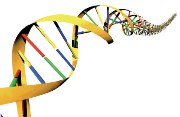ARS researchers unlock basis for corn diversity

Agricultural Research Service (ARS) scientists have developed a massive genetic resource for geneticists and breeders to unlock the basis of corn diversity. The scientists found that most natural genetic variation in corn is the product of numerous genes working together, each with a small effect that could be manipulated by breeders.
Major funding for the project is provided by the National Science Foundation. The findings were published today in two papers in the journal Science. This work also provides major insights into hybrid vigor, a key element of today’s high-yielding crops. The scientists’ findings will change the way breeders improve crops using today’s high-efficiency molecular technologies.
These findings by ARS scientists and cooperators may help researchers determine the role of genes in agronomic traits such as yield, fertilizer use efficiency, drought tolerance, and ethanol potential.
In their research, the scientists developed and assessed more than 1 million corn plants–the largest published genetic study to date. Corn (maize), one of the world’s most important food crops, is also genetically 15 times more diverse than the human genome. So it’s important for scientists to learn about key gene variants in the maize genome and the role those variants play in various traits.
The ARS scientists in the project were led by plant geneticist Ed Buckler at the agency’s Robert W. Holley Center for Agriculture and Health in Ithaca, N.Y.; plant geneticist Michael McMullen at the ARS Plant Genetics Research Unit in Columbia, Mo.; and plant geneticist Jim Holland at the ARS Plant Science Research Unit in Raleigh, N.C. Joining them were ARS computational biologist Doreen Ware at Ithaca, and ARS plant geneticist Sherry Flint-Garcia at Columbia. The ARS researchers worked with industry and university cooperators in the United States.
Hybrid vigor is responsible for the incredibly productive corn hybrids grown across the United States. These researchers found that hybrid vigor results in part because hybrids bring together optimal gene combinations that are unlikely to occur in current breeding schemes. Novel breeding schemes designed to exploit this new knowledge of gene combinations will accelerate plant breeding worldwide.
The articles are entitled "Genetic Properties of the Maize Nested Association Mapping Population," and "The Genetic Architecture of Maize Flowering Time." They can be viewed at http://www.sciencemag.org.
ARS is the principal intramural scientific research agency of the U.S. Department of Agriculture.











